
Let me issue a bit of a warning before we get too far into things this week. This will be a bit ranty, but I’ve done my best to keep it to a minimum! I found myself brought into a discussion on Twitter that I quickly realized was just too good to not talk about in Anything But, but we’ll get to that in a little bit. First let’s jump into this week’s Competitive Corner…

For the second week in a row, we’re going to see Fissure sliding, which I think is a great sign. Perhaps it is finally reached that point where people really understand the match and how to beat it because it really hasn’t lost any power. If anything the deck has become more refined at this point with the Simic version falling from grace and the stronger Azorius version quickly becoming the most popular. For better or worse we also see a new deck coming up on top this time around.
Daily Event Results 7/12 – 7/26


Last week it was a relatively close race between Stompy and DelverBlue when it came down to who would be the first to overthrow FissurePost’s reign. This time around DelverBlue managed to take that top spot and by an advantage of almost 10. FissurePost walked into third, coming back from the fourth place finish of last week. The third place deck from last week, Affinity, managed to only bring in 33 total showings, almost 20 behind last week’s total. Most of the top decks declined in totals from last week to this week, but this was balanced out by a larger number of decks ending up in non-rogue status. I think this helps illustrate the point I’m going to get to in this week’s article as things start to settle out. We get almost a more even distribution between these decks at the top… almost.
Here’s this week’s rogues…
1. Burn – 5
2. GreenPost – 4
3. Hexproof – 2
4. RebelPost – 2
5. Teachings Control – 2
6. DimirTrinket – 1
7. MWA – 1
8. Reality Acid – 1
9. DimirPost – 1
10. Cyborgs – 1
11. Tortured Reanimator – 1
12. OrzPost – 1
For the last few weeks we’ve seen the rogue count at record highs as it approached 40 week to week. Unfortunately this week, as things continued to round out amongst the remaining top decks, we’ve seen a drop off in our rogues. At only 22 there were still some fun things showing up including my favorite, GreenPost, at four wins. This deck I think had a great shot in the Affinity-heavy metagame and even could draw up some good stuff against rival Post decks thanks to a significant amount of main deck options for land destruction. We also see a return of one of my favorite control decks in the format, Teachings Control. While it was only a 2-off showing, it is nice to see some options for control showing up again beyond DelverBlue. Other oldies, but goodies, included RB Tortured and OrzPost.
Here’re how the undefeated odds are looking…
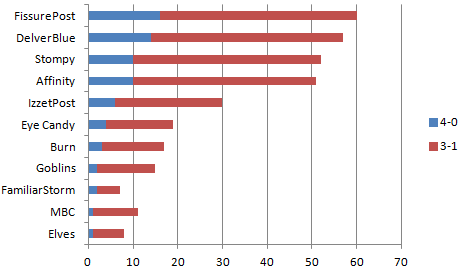
We actually had a few shake-ups occur here as Affinity and Stompy have shifted places as Affinity continues to fall. A bit of a spoiler alert here, but even in our Daily Event Spotlight we’re starting to see Affinity fall. We also saw Burn fall down three places as Eye Candy continues to settle out as it is finally getting past the start of zeros as a result of the deck not existing… Anyways! If you remember last week I was mourning the loss of FamiliarStorm, which is one of the strongest decks when it comes to undefeated showings. However, things have gotten right in the world as the deck managed to have a really strong week and reappear. This week alone the deck had 11 showings with five of those being undefeated as it again works on going undefeated in near 50% of its decks. That being said, we did have a casualty as Hexproof falls off the list. There will always be some issues with these low-end decks as averages continue to fluctuate.

Here’s this week’s Daily Event breakdown…
Fast Stats!
Daily Event: 5712234
Number of Players: 60
Deck Types Represented: 14
Packs Won: 134
There were 60 players who showed up for this event. Among these 60 players, there were 14 different deck types represented, quite a drop from recent weeks. The most prevalent deck this week was DelverBlue. Since I started tracking specific events we’ve seen Affinity as the heaviest-played deck in every since Daily Event, but this week not only was it beaten for the number one spot, but it comes in at fourth overall, 11 players short of DelverBlue. Here’s the full breakdown…
1. DelverBlue – 15
2. FissurePost – 9
3. IzzetPost – 8
4. Affinity – 6
5. Stompy – 5
6. Eye Candy – 5
7. Burn – 3
8. Goblins – 2
9. MBC – 2
10. Hexproof – 1
11. Illusions Aggro – 1
12. RGLD – 1
13. UB Control – 1
14. FamiliarStorm – 1
By the end of the second round, there had already been fourteen players eliminated. Another fourteen players would be forced to drop from the tournament by the end of the third round with no hopes of ending in the money. This week’s condolences go out to Kaager, RockyC, and weder00, who all started out 2-0, but would go on to lose their next two rounds, which would keep them from the 3-1 minimum. Here’s how the decks matched up this week…
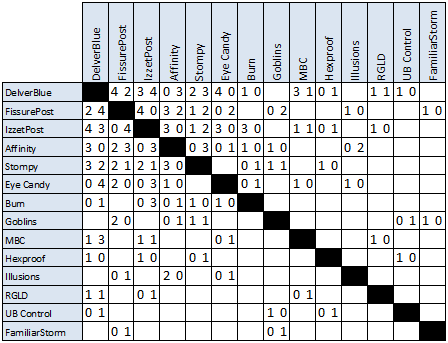
Eliminating outliers, this week’s top performer was Stompy, which came in with just under a 67% win rate. Other top performers include IzzetPost with a 59% win rate, Goblins at 57%, and DelverBlue at just fewer than 56%. We also saw the one player running Hexproof went 3-1 for a 75% win rate. At the bottom of things, we saw Burn at just over 28%, Affinity at 37%, and Eye Candy at 38%. In an interesting twist we also saw FamiliarStorm, which has one of the best records for undefeated showings as I mentioned earlier, drop after an 0-2 start. We also saw some other poor showings from some of the other rogues like UB Control and RGLD.

There were a small number of undefeated showings this week, but a decent number of overall showings as always. Only four players managed to reach that 4-0 mark with Stompy getting the majority with two players who went undefeated with the deck. The other two undefeated players were running DelverBlue and IzzetPost. Beyond that there were fifteen decks ending up at 3-1 record for a total of 134 packs won in this event.

The Internet is a great thing for many different reasons. Without diving too far into the argument about “net decking” I think it’s safe to safe that the Internet has provided us with a lot of great opportunity for community interaction. In the realm of you-never-wanted-to-know-but-I’m-going-to-tell-you-anyways, I worked on a lengthy paper in college (treading water in the triple digits section) discussing how tools such as the Internet could be used as a collaborative platform to elevate knowledge to a higher level. Okay I get it, what does this have to do with Magic?? Well, applying that idea to the game we all love simply means that we have many outlets to collaborate on deck creation and evolution of our metagame. The use of platforms such as forums can provide healthy discussion that is OCD-friendly (yay for organized by topic!!). We’ve also seen the use of social media platforms to enhance community interaction. Facebook has become an incredibly useful resource, and if you don’t already, I suggest following deluxeicoff’s and Alex Ullman’s Facebook pages. Then we come to Twitter.
I’ve always been a wordy person. I think any of my regular readers would easily agree to this, having sat through any number of long articles, and I know when I sit down and put together these articles in Word, my page count is longer than the average paper length I had to write for school. Keeping this in mind, I think you can understand the love/hate relationship I have with Twitter. There are some good things about the social media site — don’t get me wrong. Through this you have an opportunity to directly interact with many of Pauper’s great contributors. You learn more about them outside of the game as well as passing thoughts they have about everything in game. I know that from following some members from the Magic community I’ve had a laugh or two (admittedly sometimes at their expense). However, what makes Twitter, Twitter is the 140-character limit. This is where the problem lies.
Let me put you in my shoes for a minute. I have a few real-life friends on Twitter, but for the most part the purpose is Magic-related. I like to use it as a podium to get up and complain about bad luck, mistakes, and the occasional troll/rage quitters I meet in game. For the most part it’s a quiet scene and you often start to wonder if you’re talking to yourself. Maybe there is something therapeutic to the idea that you can sit and vent to no one and everyone at the same time. But every now and then my Twitter explodes, and when I say explodes, I mean explodes: times where I sit at home in my apartment and regret having that Twitter notification on my phone. I’m sure others can relate to this situation. Someone has started a “deep” or in-depth conversation topic on Twitter and included four or five different people on it. Now everyone who was included and replies sends a notification. Even worse, everyone who sees everyone replying to the post and replies sends you a notification. That reply button on Twitter is evil! I swear it! Pure evil! Those passing white-collar jokes about the person who accidently hit “Reply All” on an email, thus telling the whole office something personal and embarrassing, are the epitome of Twitter hell. By default when you reply to a Tweet, it automatically includes all people who were included in on the Tweet.
Okay, so now you’re reading this article and we’re a couple paragraphs in, so you’re wondering where I’m going with this. That was partially a public service announcement, but more importantly allow me to get to my point. The discussion is great! If this was a forum, we could all put down our thoughts and convey clear points. The fact that the person who started this reply hell had something to say that was so great that others wanted to add their own thoughts means that it was probably something worth talking about! A novel concept on Twitter, I know. This does happen, though, and there have been some “great” discussions about Pauper’s bannings and metagame just to name a few things. I do hesitate to say great because again we find that we’re limited by the 140-character limit. Imagine if you will having an educated discussion on some political topic, but being limited to only 140 characters. How do you effectively get your points across?? Not that long ago now I wrote an article on my thoughts of the EyeCandy deck as a result of this 140-character limitation. Thankfully for me, I do have this alternative soap box that the lovely gentlemen of MTGO Academy allow me to stand on and voice my thoughts and opinions to the Pauper community.
So what recent discussion on Twitter has me on the box today? Well, if you follow me on Twitter you might already have an idea of what discussion I’m talking about. If you don’t, well, take a minute, stop reading, and go follow me! Sitting at my computer while doing some work I saw a retweet from Chris Plummer that caught my interest. Let me add quickly that I became one of those people jumping in on a conversation that wasn’t involving me in the first place, thanks to Twitter. So here’s the Tweet in question…

This one tweet managed to pull in at least 20 additional responses. In 140 characters I could basically respond…

But I wasn’t satisfied leaving it at this. The health of the Pauper format is really a discussion that cannot be summed up in 140 characters. What caused Greystone concern was information he found on MTG Goldfish, which, for those who are not familiar, is a site that gives you information on metagames as well as card frequencies and prices. Before we go further, allow me to issue a bit of a public service warning. This isn’t the first website of its kind and certainly won’t be the last. Ideally what sites like this do is to take the results data provided by Daily Events in order to tabulate data in a similar way that I do each week. My caution is that I find that some of the data provided by these websites can often be unreliable. This usually comes into account when talking about metagames because automatic classification can make mistakes, and I’ve found what they show occasionally does not match what I have tracked myself. Okay, so let’s take a look at the data in question…

If you haven’t been able to put it all together, let’s take a minute and explain the argument being made here. This is a copy of the information from MTG Goldfish based on what the top cards in Classic Pauper are. With the heavy presence of blue throughout these different lists, the argument is being made that because the format is so heavily influenced by blue spells, it has presented an unhealthy format. The first thing that has to be mentioned is that we’re going to assume that these numbers are all correct. I have very little reason to believe that these places are incorrect, but I’m not going to be verifying it myself, and therefore I’m always likely to take it with a grain of salt.
When we take a look at the top spells in Classic Pauper, we see a heavy influence of blue, and based on the provided numbers, this shows that we’re looking at most of these holding a place in forty to fifty percent of the decks being played. When this is your first glance at the format, it is pretty easy to see why someone might consider the format to be broken; however, this snapshot of the format is a terrible view. Let’s take a minute and just consider this website for a minute before we get into the actual Magic side of things. This website is called Goldfish. Consider that for a second if you will, and imagine yourself as a child back when you attended that school fair and walked away with that tiny little goldfish in a small glass bowl. While that little fish may have only lived about a week, the memory lives on. The biggest concept that the little glass bowl was able to imprint on your memory was things like how big that little goldfish looked. If you’ve ever done anything with film or photography, you know about fisheye lenses, which work to create a visual distortion of an image.

In the same way that this distortion is created through a fishbowl, I feel we’re seeing a distortion of the current metagame. Just because certain cards are heavily played doesn’t mean that the format is in bad shape. Perhaps it’s because we’re so focused on our own formats and not necessarily others, but I feel I hear more complaining from the Pauper community over balance than I do from others. Perhaps this is because when things are broken in other formats it’s more obvious, but I think for comparison’s sake, let’s see what the top cards are in some of these other formats.
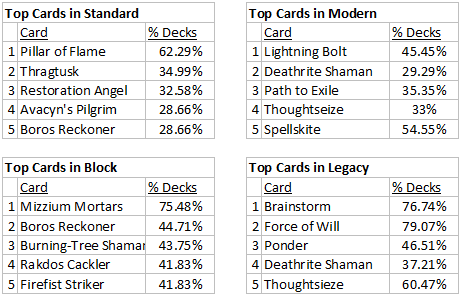
The first thing that you should get from these tables is that this list as provided by MTG Goldfish is ranked based on the concept of “dominance”. According to the site, the value of dominance is equal to the total number of the card divided by the number of decks times four. A card that is 4x in every deck would have a 100% rating. I won’t even begin down the path on my thoughts about this number, but personally I’d consider the more important number would be the percent of decks. This is why on the Legacy list we see Thoughtsieze listed at number five even though it was found in over 60% of the decks tracked. In some cases these numbers might seem more even, but what you’re not seeing from these lists is the fact that in practice, a good number of these cards in the top five are all found in the same deck. When we look at a format like Legacy that has access to the best, unrestricted dual lands you’ll find it very common to see a deck that runs a focus on blue for countermagic and Force of Will paired with a small black splash for those Thoughtsiezes. What is perhaps more offensive to some people would probably be the fact that in Legacy you get the top two forcing their way in at a number dangerously close to 100%. All of a sudden the fact that Preordain doesn’t even break 49% seems pitiful.
When we talk about Magic, there are so many different levels involved. At the core of constructed play, players are running a deck with a minimum of sixty cards with additional rules imposed based upon the chosen format. As we focus in our look at that deck closer you see a variety of card choices with colors matching lands and a limitation that tells us we can have no more than four of an individual card in our deck. When we make decisions for the cards within a deck there are a number of different factors that influence our choices. In most cases, you start building a deck by throwing in a win condition and build off of that with things to either find or protect our win condition as well as things to handle our opponents’ win conditions. In Pauper we actually find ourselves quite limited in our card choice thanks to that simple commons-only restriction. By removing the uncommons, rares, and mythics from our possible card pool, we’re not given choices to pull off amazing combos or broken interactions at the same level as other eternal formats. Now don’t get me wrong here — Pauper gets a bad rap for its power level and I think some doubters would be surprised, but I grant that we’re not getting cards like Emrakul, the Aeons Torn that end the game almost as soon as they hit the table.
During my time on Twitter I’ve come to learn something about a good portion of the Magic community. We’re gamers. I’m sure this is obvious to most, but this goes well beyond cards or even boards. I’ve found that several of my fellow Magic players are also fans of other popular video games like League of Legends and Starcraft 2. I apologize for anyone who doesn’t play video games because I might lose you here with this next comparison. Consider for a second the fact that a majority of the Classic Pauper metagame is made up with aggro-centric decks. Even the top control option, DelverBlue, is built on a base of around 20 creatures with a supporting cast of other spells to round things out. MOBAs like League of Legends and DotA2 are some of the most popular games out there today. In these types of games the characters are generally classified as either support or carries. I think this idea applies to Magic as well. For those who are not familiar what generally happens, the carries are the heavy hitters. From the start these characters focus on damage and are the ones you’re going to rely on to do most of the damage for your team. Meanwhile the support characters start off down a path focused on other beneficial skills as they provide things like crowd control or heals and protection for teammates.
I think the best example of this would be in a deck like Affinity. In this deck the role of carry would obviously be that of the creatures. In this particular case you’re going to be looking at those big-bodied creatures such as Myr Enforcer or even the threat of a big creature like Atog that you’ll be relying on to do the heavy lifting in your deck when it comes to doing damage. However, you’ll need more than just these creatures to win the game. You’re going to need supporting spells like Galvanic Blast that will help keep opposing creatures off the board while Thoughtcasts will help refill your hand as you empty it. While some decks can get away with having almost no non-creature spells (such as Stinkweed Zombies) they focus on that gray area in my logic with creatures that will act as both your damage focus and support, and the majority are going to require a balance between the two. I think Affinity is a great example because it uses creatures like Frogmite and Myr Enforcer, which work like Hill Giants… creatures there just for size and no other supporting abilities.
Consider the color pie for a minute, if you will. While the lines between the colors are much more complicated than you may realize, we’re aware of the fact that each color in the Magic universe has a specific approach associated with it. For example, red is best-associated with fast burn and direct damage spells while green is best associated with big-bodied creatures. If we were going to associate colors with roles based on the carry/support structure, than you’d probably consider green to be a carry while a color like blue would most likely be best-associated with support. If we start to push this concept beyond just the Classic Pauper format, you’ll find that if you’re putting together a deck, you’re likely to draw from certain colors like green for your big stompy creatures and then supporting them with a handful of blue spells that provide you with things like draw as well as protection in the form of countermagic. This is a similar concept to what you’re seeing in classic Pauper.
At the top of this “most played cards” list we find Preordain. This alone represents the very foundation of the concept I’m trying to convey here. Just consider for a second how many decks we’ve seen run Preordain…
DelverBlue
FissurePost
FamiliarStorm
UB Control
DimirPost
DimirTrinket
AzTrinket
IzzetPost
Reality Acid
Eye Candy
IzzetControl/Aggro
MUC
Teachings (though it’s a terrible idea)
EnchantStorm
SimicPost
There are also several other very rogue decks including EsperAggro variants and Simic Defenders. According to the card listing, Classic Pauper sees Preordain in almost 49% of the decks, but considering how many decks the card has seen play in, I think that seems quite reasonable, all things considered. Doing the math, based upon all the numbers I’ve tracked since the last bans were put into place, there are a total of 20 different decks that have/currently do run Preordain. Seeing 49% of the meta running this one card really tells us nothing. If you want to know what impact this has, then there really has to be a better comparison because here’s how much of the current metagame these decks make up…
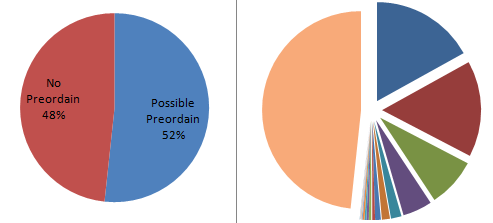
Now this particular chart gives you a much better look at the breakdown. These 20 decks account for 52% of the metagame, which doesn’t sound terrible to me. Things do look a bit more lopsided when you break that 52% down into its actual parts because — face it — that 52% is not going to be divided into 20 even pieces. What we’re really seeing is probably 5 decks with Preordain making up 50% of the metagame, but even that “statistic” is a bit misleading. While we do have 5 decks accounting for 50% of the metagame, this kind of information is not taking into account some of the other continuously top decks that don’t use Preordain. Look at how strong decks like Affinity and Stompy have been over the past few weeks.
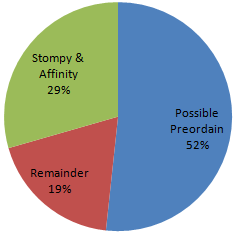
Hopefully the point I’m trying to make is becoming clear. The more data you add, the clearer the picture of what the meta is made up of becomes. I’m sure there will be those people who are doing the math here and understanding that we’re now looking at seven decks that account for 81% of the metagame, but that isn’t really what we’re concerned with here. The big argument being made was that, because the heaviest-played cards in the format are blue, the meta is unhealthy, but we’ve just shown here that there are a significant number of strong showings from decks not running those blue staples.
So am I saying that our format is completely healthy? No, not exactly. Don’t get me wrong here — I think there are some issues with the format, but nothing that you wouldn’t expect to see in any other format that has been presented to us by the minds over at Wizards. To this day, I continue to say that I think there is a problem with Temporal Fissure. However, the theme of today is the idea that you can’t just focus on one factor. I can sit here and tell you why I think this one particular card is bad for the format, but it doesn’t really show the future value. This past month we’ve seen a decline in FissurePost, which was the most-played deck for many months. While I think Temporal Fissure might be detrimental to the forma,t take into consideration that it’s now on the downswing.
I’m always skating past the rules on averages and testing the lines between Magic writer and math teacher, but you have to make some considerations on any numerical information. When creating an average, it can take a while for some of the numbers to balance out. In the case of a new set being released and impacting any format, we see new decks emerge such as Eye Candy. What this showed us on our average showing numbers was how the numbers can be skewed for a while until you have more data points to pull from. This means that we won’t be seeing the impact that the recent down turn in FissurePost will have for perhaps a month or more when it comes to creating statistics or polling data. The other thing we’re unsure of with these data, and someone can feel free to clarify it for me because looking over the website I can’t determine it, is that we don’t know how these particular data are being pooled. There are so many variables that go into math and data reliability would rely on knowing things like what time period is being covered. Without knowing that, we don’t know how old the data are, how much time over which they are being averaged, and what we can expect from future data based on what we’re seeing.
The other assumption I’m bringing in based on these data is that they are going to only include data points from Daily Events that have been posted by Wizards. With this information being restricted down to only one event per day, the numbers I provide you guys week to week based on deck totals are already incredibly unreliable, but at the very least I provide a generic overview. I try and supplement this loss of information by pulling in a Daily Event in full detail each week (time permitting of course), and what this has shown me is that while there may be a certain set of decks holding the most spots over a week, there is a much different breakdown in what we’re being shown and what people are actually playing.
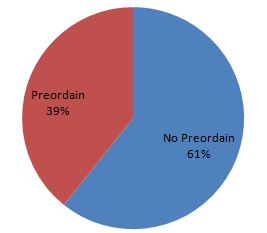
As you can see, the breakdown goes in quite the opposite direction. This information is actually compiled from the results of seven different Daily Events, taking a look at what every player in that event was running. To me this information shows that people want to be playing something other than blue. So I know what you’re starting to think now. This chart shows what the total showing is, so based upon the earlier breakdown of decks with Preordain versus decks without Preordain, things are very different; clearly the explanation is that, while people are playing fewer decks running blue, the decks that are winning are the ones who do decide to run blue, right? Well, see for yourself…
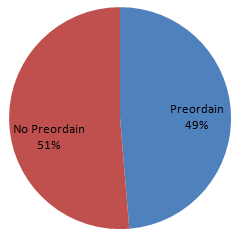
The ratio of blue versus non-blue gets increasingly closer to 50% when we focus on only the decks that ended in the money during these same events. This does verify that decks running blue are coming in close to 50% of the metagame, but is that really a reason to condemn the format as unhealthy? I guess that is going to have to come down to a matter of opinion, but I would argue that it isn’t. A format like Pauper (in any of its forms) is based upon a restriction that makes it harder for a deck to run multiple colors. Unlike Legacy, which gives access to dual lands and creates an environment that is friendly to something at even four colors, Pauper players have to gravitate more towards one color or another. This can easily be seen based just on the fact that we have so many successful decks in single colors. Not only that, but each of those single colors has multiple mono-colored decks that have seen at least some form of success in Pauper. Most other formats usually only have a single mono-colored deck in some variant of Burn or RDW. I think that’s actually a benefit to the format. You’re going to be required to ally yourself to one or another color, and it just so happens that there are currently a larger number of decks that feel that blue is the strongest option.
Is the Classic Pauper format healthy? You’ll have to decide for yourself. Thankfully in Magic, we’re offered a variety of different formats to venture into if one does not suit our fancy. It’s up to you to decide whether or not you think the current metagame is right or wrong, but hopefully what you at least take away from this discussion is that you shouldn’t base that decision simply on a single point of data, especially when that point is something as microscopic as overall card choice. Take into consideration the metagame as a whole, the decks involved, the power level of those decks, the cards available, the breakdown of what people are bringing, and so on. Based on that information you can decide for yourself whether that is good or bad. I urge you to not take my word for it or that of anyone else in the community because the decision is yours and yours alone. All I ask is that when you do come to that decision, make sure it is a well-informed one.
Well, that’s it for this week, everyone; hopefully people don’t mind too much when I take the series into these mildly ranty topics, but I believe this was well worth discussing. Until next time, everyone, don’t forget you can check me out on Twitter @MTGOJustSin in the meantime, and then you too can limit me to 140 characters in my responses to your questions and concerns!

very in-depth and analytical post, most esp the top cards used in Pauper.
Ill post this in our group
thanks, glad you enjoyed it
I too am very wordy and was heavily restricted in my response to the tweet so I’ll put it here because I’ve been thinking about it a lot. Even if blue is overplayed, who cares? As you eluded to focusing in on the amount of a color is kind of a naive way of looking at a meta, focusing in on archetypes is where the analysis should lie. In Pauper blue enables Delver (Tempo deck), U/R Cloudpost, Trinket Control, MonoU Control (Control decks), Fissure decks, Eye-Candy (Combo), and Azoriouskitty/Reality Acid (Midrange). How many archetypes would white enable, if people weren’t restricted by Pauper’s unforgiving meta? My guess is 2-3, maybe aggro or midrange?
I get that people want to play other colors besides blue, but people also want to play different archetypes and strategies. The way the color-pie has worked form the dawning of time (1992), blue is the color that allows you to play multiple strategies the best. It really can weasel its way into every archetype besides non-fish/non-tempo aggro decks like stompy. So a metric that says blue is the most played color could also mean the format is healthy and diverse – like how I feel it is now.
This made me laugh: “For the most part it’s a quiet scene and you often start to wonder if you’re talking to yourself…”
WHOLE reason I made the page, was to not only focus minds on weird brews…of which I’m very fond, but mostly to stop irritating all my ‘Non-Magic’ friends (which is almost everyone!) with posts that sound like some foreign language to them
It is pretty amusing that the top 5 lands in the format are 4 basics followed by cloudpost.
I could not agree more haha, I wanted to mention that, but figured it would open a can of worms I didn’t want to jump into